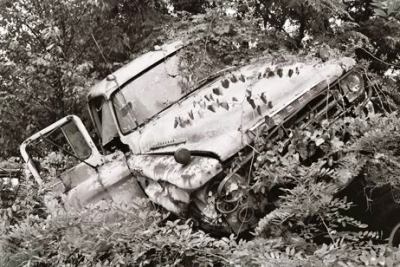In 1970 Ballard organised an exhibition of crashed cars at the New Arts Laboratory, simply called "Crashed Cars". The crashed vehicles were displayed without commentary, inspiring vitriolic responses and vandalism.In both the story and the art exhibition, Ballard explored the sexual potential of car crashes, a preoccupation which culminated in the novel Crash in 1973.
http://en.wikipedia.org/wiki/J._G._Ballard
Arnold Odermatt - Stansstad, 1967
Well, before starting Crash, for example, in 1969, I staged an exhibition of crashed cars at the New Arts Laboratory in London—three crashed cars in a formal gallery ambience. The centerpiece was a crashed Pontiac from the last great tail-fin period. The whole exhibition illustrated a scene from my previous book, Atrocity Exhibition, where my Travis hero stages a similarly despairing exhibition. What I was doing was testing my own hypotheses about the ambiguities that surround the car crash, ambiguities that are at the heart of the book. I hired a topless girl to interview people on closed-circuit tv. The violent and overexcited reaction of the guests at the opening party was a deliberate imaginative overload which I imposed upon them in order to test my own obsession. The subsequent damage inflicted on the cars during the month of the show—people splashed them with paint, tore off the wing mirrors—and at the opening party, where the topless girl was almost raped in the rear seat of the Pontiac (a scene straight from Crash itself), convinced me I should write Crash. The girl later wrote a damningly hostile review of the show in an underground paper.
http://www.theparisreview.org/interviews/2929/the-art-of-fiction-no-85-j-g-ballard
Each of these sculptures is a memorial to a unique collision between man and his technology. However tragic they are, automobile crashes play very different roles from the ones we assign them. Behind our horror lie an undeniable fascination and excitement, most clearly revealed by the deaths of the famous: Jayne Mansfield and James Dean, Albert Camus and John F. Kennedy. The 20th century has given birth to a vast range of machines – computers, pilotless planes, thermonuclear weapons – where the latent identity of the machine is ambiguous. An understanding of this identity can be found in a study of the automobile, which dominates the vectors of speed, aggression, violence and desire.
In particular, the automobile crash contains a crucial image of the machine as conceptualised psychopathology. Apart from its function of redefining the elements of space and time in terms of our most potent consumer durable, the car crash may be perceived unconsciously as a fertilising rather than a destructive event – a liberation of sexual energy – meditating the asexuality [sic] of those who have died with an intensity impossible in any other form. In 20th century terms the crucifixion would be enacted as a conceptual car crash.
The car crash is the most dramatic event we are likely to experience in our entire lives apart from our own deaths.
http://www.slashseconds.org/issues/001/001/articles/13_sford/index.php
Jo Stanley at the private view of Crashed Cars, 1970. (Frame from the original video tape of John "Hoppy" Hopkins.)
In 1970 Jim staged his notorious Crashed Cars exhibition at IRAT (Institute for Research in Art and Technology) in north London.
‘I suggested we hire a young woman to interview the guests about their reactions,’ Jim said. It was implicit in his suggestion that the woman be nude. The girl who accepted the job, Jo Stanley, wasn’t part of the IRAT collective. ‘I believe Jo was a model,’ says [videographer John "Hoppy"] Hopkins. ‘She had big breasts, so that was quite an eye-catcher, and exciting for the blokes anyway. She was quite natural and spontaneous. She became a personal friend very quickly. She was a lovely person.’
On the telephone with Jim, Stanley agreed to appear naked, but once she met him and saw the cars, she changed her mind. ‘It was so delicious,’ Jim recalled to Iain Sinclair, still excited three decades on. ‘She walked into the gallery. She said, “I won’t appear naked. I’ll only appear topless”. I thought, “That’s interesting”. She saw the sexual connection.’ It inflamed him that she understood this wasn’t simply an art show, but the realisation of his sexual fantasy."
John Baxter
https://sites.google.com/site/johnbaxterparis/home/j-g-ballard-1
Charles Ray - Unpainted Sculpture, 1997
As advertised in Art & Artists, 'Jim Ballard: Crashed Cars' took place at the gallery between 4-28 April 1970. The cars – a Pontiac, an Austin Cambridge A60 and a Mini – were hired from Charles Symmonds's knacker's yard, Motor Crash Repairs. 'They don't appeal to me as art,' Symmonds told the Sunday Times. 'I detest cars. But maybe it's a good idea to show crashed cars. It's frightening.' Ballard's choice of car was far from accidental. The Pontiac was a model from the mid-fifties, and thus represented a particularly baroque phase in American car styling, while the Mini symbolised the fun-loving mobility of the swinging sixties. The sober and conservative saloon, the A60, stood for the Mini's exact antithesis. All however, through the catastrophe of the car crash, were now in a sense equivalent; smashed and levelled to the raw material of their crushed metal, broken glass, and stained upholstery.
Simon Ford
http://www.slashseconds.org/issues/001/001/articles/13_sford/index.php






1 comment:
Order a professional Sparkling White Smiles Custom Teeth Whitening System online and enjoy BIG SAVINGS!
* Up to 10 shades whiter in days!
* Results Guaranteed.
* Better than your dentist.
* Same strength as dentists use.
Post a Comment